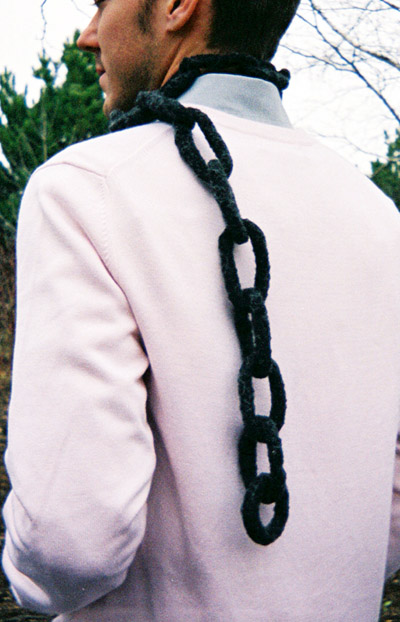

 by
Alison Gates by
Alison Gates

Here's a chain for a scarf
or belt inspired by some gold polyester necklaces
in Marc Jacob's Spring collection and by the
scarves on the cover of Teva Durham's book,
Loop-d-Loop, but with one big exception: fulling.
Fulling stabilizes this knit chain so that it
can bear weight and will withstand stress.
The fulling process was interesting
for me because the links on my samples all felted
only into to themselves and remained chains
of independent links -- how cool is that? Once
you've learned the basic technique, you can
improvise: try chain mail, for instance, or
change needle size and yarn variety to make
belts, scarves, purse handles, and jewelry.
The chain doesn't necessarily
have to be fulled if a stretchy chain is appropriate;
therefore, you can also knit links of different
yarns into the same chain, including non-woolens,
to use up scrap. Three loops can be joined to
make a nice "eternal ring" effect
as well. Small needles and smaller yarn works
too. You can also weave flat ribbon through
your chain to get the same look as the chain
strap on a Chanel bag.
|
|
 model: Cory Linsmeyer
model: Cory Linsmeyer
 photos: Alison
Gates
photos: Alison
Gates
|
|
| Size
is variable. |
| |
|
Chain
shown has 27 links and measures 50 inches in length
after fulling.
|
| |
| |
|
 Brown
Sheep Lamb's Pride Knitting Worsted [85%wool, 15%
mohair; 190 yds/171m per 113 g skein]; color: #M06
Deep Charcoal; 1 skein
Brown
Sheep Lamb's Pride Knitting Worsted [85%wool, 15%
mohair; 190 yds/171m per 113 g skein]; color: #M06
Deep Charcoal; 1 skein
 1 set US #9/5.5mm double point needles
1 set US #9/5.5mm double point needles
 Crochet hook or tapestry needle for weaving
in ends
Crochet hook or tapestry needle for weaving
in ends
|
| |
|
For once, gauge is unimportant.For chain shown,
it was 5 stitches = 1 inch on US 9/5.5mm needles.
|
|
|
| [Knitty's
list of standard abbreviations can be found
here] |
For best results, weave in
your ends as you go.
Work in the tail
from your cast on by working the first round
with a double thickness of yarn (yarn tail
held together with working yarn) until you
run out of yarn.
Use the crochet hook or tapestry
needle to weave in the tail from your bind
off, before beginning the next link in the
chain. Because the links will curl so that
the WS (purl side) shows, weave your ends
in on the RS of the work.
If
you are unfamiliar with working with double-point
needles, instructions can be found here.
|
  First Link
First Link
Using a long-tail cast on, CO 21 sts. Divide
evenly between needles and join to begin working
in the round, being careful not to twist.
K
3 rounds.
BO
all sts.
The
circular strip you have knit will curl up on itself,
forming a tubular ring.
*Next Link
Using
a long-tail cast on, CO 21 sts, and divide
evenly between needles. Before joining work,
slip previous link over the needle that is
not connected to the working yarn, and slide
it onto the center needle. Join to begin working
in the round, being careful not to twist.
K
3 rounds. Each time you finish knitting the sts
on one needle, slip link to next needle, so that
it does not get in your way.
BO
all sts.
Repeat
from * for each subsequent link, or work in sequence
described below:
Metalsmithing Tip
Knit
up a bunch of single links (follow instructions
for First Link), then join a pair at a time
by following the instructions for Next Link,
but slipping 2 sts over the needle before
joining, instead of 1. It's a little trickier
to move 2 links around the needles, but this
is the way metalsmiths and jewelers make chains
and it can save you some time. (It's also
a helpful trick to know if you forget to string
a link before you join your sts to work in
the round!)
|
| |
|
When
the chain has reached the desired length, you are
ready to full the chain. Fulling requires simply washing
the chain in the washing machine on a hot wash/cold
rinse cycle with mild soap 2-4 times, to get the wool
to felt a little bit. Throw in a pair of jeans for
extra friction. Your stitches should almost disappear
in the process. When the chain has been fulled to
your satisfaction, you can clip any stray ends that
may have worked themselves out in the wash, without
any fear of unraveling your hard work.
|
|
  Alison
Gates learned how to knit at age 7 from her
mom, but didn't finish a darn thing till she
was over 30. Alison
Gates learned how to knit at age 7 from her
mom, but didn't finish a darn thing till she
was over 30.
Now, as an assistant professor of art and design,
she instructs an average of 20 students how to knit
all at the same time in less than 2 hours every semester.
(She actually teaches all the textiles courses, some
design and a little bit of Women's Studies at the
University of Wisconsin, Green Bay.)
|
| Pattern & images
© 2005 Alison Gates. Contact
Alison |
|

